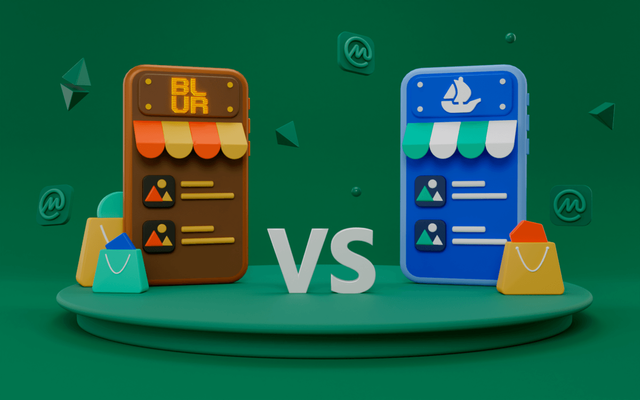
The Rise of Blur: Shaking Up the NFT Marketplace
Hold on tight, folks, because there's a new sheriff in town. Blur, with its daring and disruptive approach, has swooped in and claimed the throne in the NFT marketplace. With a staggering 65% market share and an eye-popping $442 million in sales, Blur has left its competitors scratching their heads and scrambling to catch up.
So, what makes Blur stand out from the crowd? Well, for starters, they've thrown out the traditional playbook by introducing a zero royalty fee model. In other words, they're saying, "Hey, artists, you deserve to keep every penny you earn." This bold move has resonated with the NFT community, empowering creators and making Blur the talk of the town.
But that's not all! Blur has also unleashed a flurry of airdrop campaigns, luring even more users into its NFT universe. Picture this: free money raining down on eager participants. It's like a digital treasure hunt where everyone has a chance to strike it big. These airdrop campaigns have not only attracted traders but also caught the attention of influential individuals who are looking to make a quick buck. With zero royalty fees and tempting incentives, Blur has become an unstoppable force, leaving its rivals in the dust.
OpenSea's Struggle to Keep Pace
Meanwhile, over at OpenSea, the once-mighty heavyweight of the NFT realm, things haven't been going so smoothly. Despite their respectable 27% market share and $183 million in revenue, OpenSea has been left scrambling to keep up with Blur's disruptive tactics.
At first, OpenSea hesitated to lower creator royalties, fearing the wrath of the industry. But as Blur's popularity soared and traders flocked to its platform, OpenSea found itself backed into a corner. Faced with the pressure to compete, they reluctantly adopted the zero royalty fee model, hoping to level the playing field.
Little did they know that this decision would backfire in a big way. The NFT community unleashed their fury, accusing OpenSea of selling out and turning their backs on the creators they once championed. The backlash against OpenSea only intensified as Blur's airdrop campaigns continued to entice users, making it an uphill battle for OpenSea to regain its footing.
But here's the interesting part: even though Blur has snatched the lion's share of the market, OpenSea still boasts a significantly larger number of traders. Imagine that! Despite the flashy allure of Blur's incentives, OpenSea manages to draw in a whopping 377,087 traders compared to Blur's modest 36,673. It's like the tortoise and the hare all over again. OpenSea's ability to attract traders speaks volumes about the loyalty and trust they've built over time. Sure, Blur may have fewer traders, but its trading volume continues to outshine OpenSea's, thanks to those enticing offers of free moolah.
The Battle for NFT Supremacy: Who Will Emerge Victorious?
As the smoke clears and the dust settles, one burning question remains: who will come out on top in this epic showdown between Blur and OpenSea? The answer, my friends, remains as elusive as ever.
Blur's meteoric rise from obscurity to reigning champ underscores the ever-evolving and unpredictable nature of the NFT industry. In this fast-paced world of Web3 technology, no one can rest on their laurels. The game can change in the blink of an eye, and those who fail to adapt will be left in the digital dust.
So, what lies ahead for OpenSea and Blur? Only time will tell.
Are you inspired by Blur's incredible success in the NFT market? Ready to make your mark in this exciting and ever-evolving industry? Well, look no further because it's time for you to create your very own NFT marketplace, just like Blur!
Dear you need to verify yourself from new comer community before posting here .
Downvoting a post can decrease pending rewards and make it less visible. Common reasons:
Submit